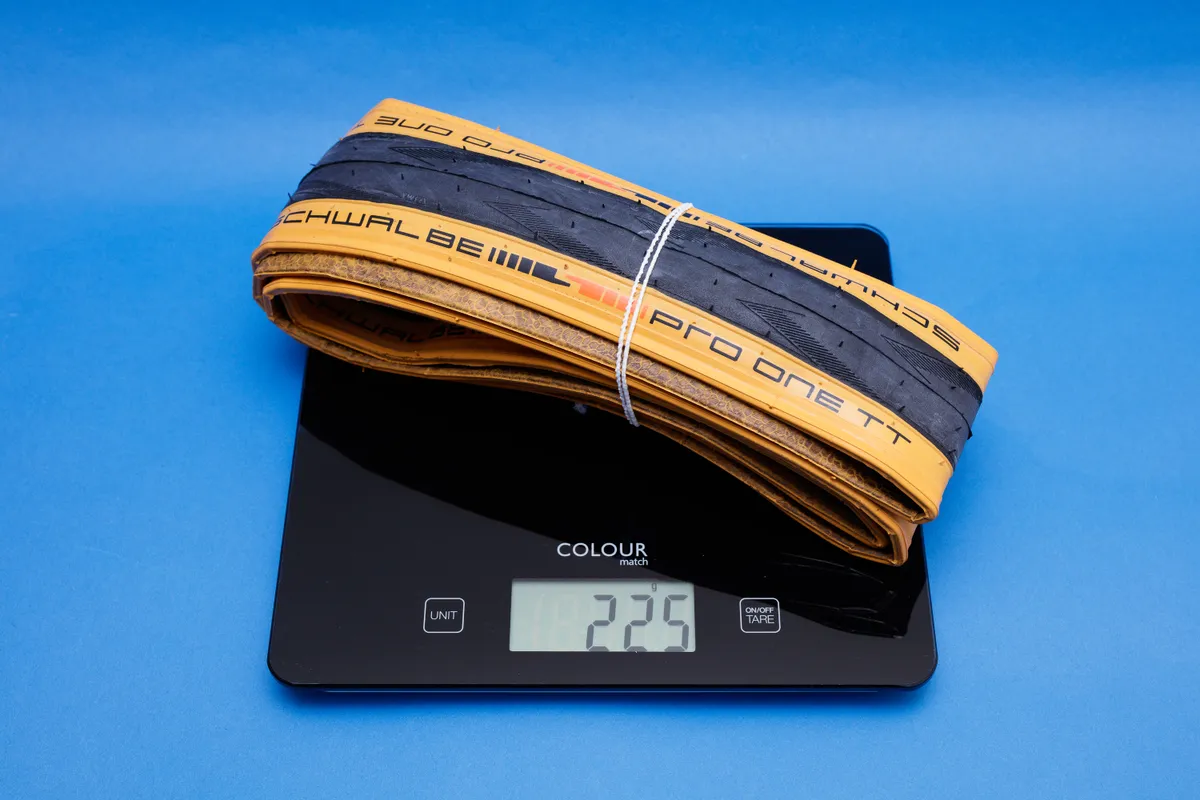The new Scott Addict's impressive sub-6kg weight is a result of a fairly exotic build, which includes the as-yet-unreleased TPU Aerothan tyre.
First teased at Eurobike 2023, the tyre is claimed to weigh only 165g for a 28mm tyre – approximately 100g lighter than an equivalent standard Pro One TLE.
More than a year after it was first shown, Schwalbe has quietly released details about the new tyre on its site and, speaking to BikeRadar, confirmed it will be launched "in 2025", with further details to come in "the following months".
The microsite outlines that the tyre is manufactured in the USA using "a patented production process with a unique manufacturing method".

Schwalbe states the new tyres are compatible with hookless rims, but also notes the "optimum compatibility" is a 29mm tyre paired with the brand's Aerothan TPU tubes.
Clincher tyres are not generally compatible with hookless rims, suggesting the unreleased Aerothan tyre will be a tubeless option.
In a statement published on the Schwalbe site, product manager Felix Schäfermeier says Schwalbe has "found a completely new way to build a bicycle tyre", adding "the Aerothan tyre sets standards that we hardly thought possible".
Our original story, published on 22 June 2023, runs below
Schwalbe has unveiled the Pro One Aerothan, a prototype tubeless road tyre with a claimed weight of just 165g in a 700x28c size.
The Pro One Aerothan tyre is said to incorporate tech from Schwalbe’s thermoplastic polyurethane (TPU) Areothan inner tubes, making it possible to cut its weight significantly.
Compared to a typical high-end tubeless road tyre, such as Schwalbe’s Pro One TLE – which weighs 264g in the same size – that represents a saving of nearly 100g per tyre.
It’s also claimed this tyre will exhibit “very low rolling resistance”, due to the nature of its construction.
While Schwalbe is coy on when this tyre will be released, one of BikeRadar’s Eurobike correspondents, Jack Luke, was able to tease out some details from Schwalbe’s UK marketing manager, Tim Ward.
TPU tyres

According to Ward, the Pro One Aerothan tubeless tyre uses technology and knowledge Schwalbe gained from developing its range of ultra-light TPU inner tubes.
These inner tubes weigh as little as 41g for a 700c tube, compared to 105g for a standard Schwalbe butyl inner tube.

While Ward declined to go into too much detail, he confirmed Schwalbe has “combined some of the technologies to create a tyre that's based around the Aerothan TPU material itself”.
With the rubber compound used in the tread of the new tyre said to be relatively standard, Ward says the secret behind the Pro One Aerothan lies elsewhere – presumably in the casing.

Ward also claims Schwalbe is the only brand in cycling (and perhaps even outside of cycling) that has produced a tyre using this construction method.
When asked if Schwalbe has patented this technology, Ward simply replied, “No comment”.

Is this the lightest tubeless road tyre ever?
We’ve seen a glut of new time-trial specific tyres in recent years, such as the Continental GP5000 TT TR, the Vittoria Corsa Speed G2.0 and Schwalbe’s own Pro One TT.
If Schwalbe’s claims are true, though, the Pro One Aerothan would beat all of them on the scales by some margin.
A 700x28c Continental GP5000 TT TR weighs 252g, for example, while Schwalbe’s Pro One TT is claimed to weigh 240g in the same size.

The only tubeless road tyre we can think of that comes close to matching the Aerothan on paper (in terms of weight) is the Veloflex Record TLR, which has a claimed weight of 175g for a 700x25c tyre.
Of course, hill climb racing aside, quibbling over a few grams isn’t likely to win or lose you many races.
However, it’s also fair to say the rolling resistance tyres exhibit tends to follow weight. Lighter tyres, for example, often produce less rolling resistance than heavier ones.

The previously mentioned Veloflex Record TLR, for example, is considered to be among the fastest road bike tyres available by independent testers such as AeroCoach – likely due in part to its ultra-light construction.
This is because there is, almost by definition, typically less material used in the construction of a lighter tyre. As a result, less energy is lost to deformation of the tyre as it rolls along the road (all else being equal).
Of course, less material often means reduced puncture resistance, but this could be an exciting development for races where every second counts.

